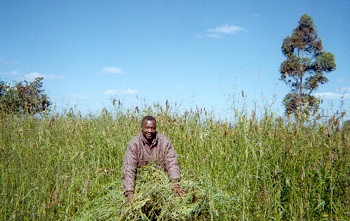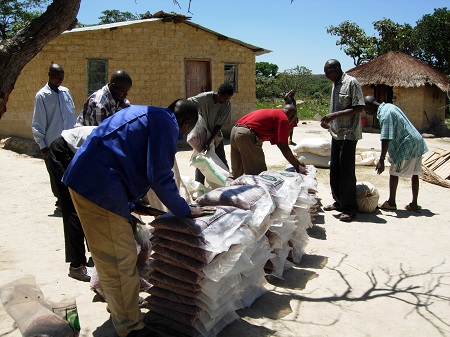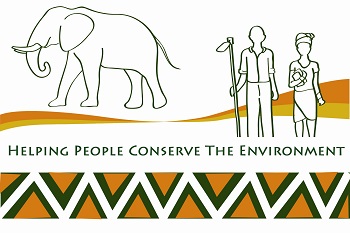Agriculture development in northern Zambia
H Farmers with Their Crops in New Food Warehouseammer Simwinga is a tropical agriculture specialist by training, holding a degree from Zambia’s College of Agriculture. He has brought his considerable talents to bear teaching rural villagers to convert from slash and burn farming to sustainable, environmentally sound methods that improve and conserve the soil, expand crop diversification and provide improved nutrition and year round food availability. Under Hammer’s oversight, food assurance in his target villages has doubled in Chief Mukungule’s area. This is the goal for the new Chiefdoms of Mpumba and Chiundaponde and beyond.
Farmers with Their Crops in New Food Warehouseammer Simwinga is a tropical agriculture specialist by training, holding a degree from Zambia’s College of Agriculture. He has brought his considerable talents to bear teaching rural villagers to convert from slash and burn farming to sustainable, environmentally sound methods that improve and conserve the soil, expand crop diversification and provide improved nutrition and year round food availability. Under Hammer’s oversight, food assurance in his target villages has doubled in Chief Mukungule’s area. This is the goal for the new Chiefdoms of Mpumba and Chiundaponde and beyond.
 Hammer and green compost, which enriches soilThe soil in North Zambia is mainly clay based and poor in nutrients. Hammer works with farmers to use improved farming techniques to improve the soil including crop rotation, green composting (planting nitrogen fixing plants and then plowing them into the soil to compost and enrich the soil for crop production), improved cultivation techniques and more.
Hammer and green compost, which enriches soilThe soil in North Zambia is mainly clay based and poor in nutrients. Hammer works with farmers to use improved farming techniques to improve the soil including crop rotation, green composting (planting nitrogen fixing plants and then plowing them into the soil to compost and enrich the soil for crop production), improved cultivation techniques and more.
Before Hammer joined Dr. Delia and Mark Owenses’ conservation project in 1994, farmers depended on maize, ground nuts and cabbage. Malnutrition was common in the remote villages because of such a limited diet and unsustainable poaching for the ‘cook pot’ was one way villagers could increase their food source. Hammer immediately introduced a variety of high protein peas and beans. He successfully introduced sweet potatoes which were very popular with villagers, grew well in the clay soil, were high in Vitamin A and had a ‘long shelf life’ after harvest. Sweet Potatoes helped eliminate Vitamin A deficiency in area residents.
“I saw villages that now have food security as a result of the various agricultural outreach and opportunities provided and supported by Hammer” Charlie Ross
Use native plants to make organic pesticides
Hammer also instituted the building of brick food storage buildings. Previously, even if a farmer had a good crop yield, a great percentage of that crop would be lost to rot and rodents. The food storage buildings are built by the villagers using bricks they fire themselves and are then stocked with each farmer’s crop for the season. A villager is hired to manage the Grainery. Villagers can come to withdraw portions of their crop yield as they need it.
Hammer also works with farmers teaching them to use native plants to make organic pesticides that protect their crops from predation.
He is also introducing the use of treadle pumps to facilitate crop irrigation in times of drought.
 Hammer Delivers Bean Seed to FarmersBean seed production is an important project for Hammer’s FWHC so that farmers can store sufficient seeds to plant the next year’s crop. However, when that is not possible, Hammer provides Bean Seed Loans to farmers and provides them with hardy seed that is specifically developed for their growing conditions.
Hammer Delivers Bean Seed to FarmersBean seed production is an important project for Hammer’s FWHC so that farmers can store sufficient seeds to plant the next year’s crop. However, when that is not possible, Hammer provides Bean Seed Loans to farmers and provides them with hardy seed that is specifically developed for their growing conditions.
A variety of highly nutritious fruit trees are native to Zambia including guava, bananas and avocados. Hammer is teaching villagers now to plant and tend their own fruit orchards so that fruit is available to them right in the village without long and sometimes unproductive searching in shrinking forests. He is also introducing orange trees to the area.
In some areas crop production has increased to the point that farmers have more food than they can eat and sell in their village. Hammer is working on marketing the excess outside of the area.
"Today, 86% of [project] participants eat three meals a day, compared with just 20% in 1986." Megan Lindow, Time.com
Funding Needs
The FWHC needs funding to achieve the following projects in the coming year:
• Raise 1,000 orange trees for sale to new farmers coming in the area
• Raise 5,000 exotic trees for woodlots in the new farming block
• Raise 2,000 assorted fruit trees for sale by 4 community schools.
• Conduct Soil and water conservation lessons in 2 communities by the end of December 2013
• Establish 40 beehives in the nature conservancy
• Conduct 6 Small Business Entrepreneurship Trainings for 150 households
• Conduct a Food Legumes Seed Multiplication Programme for 35 household to improve seed security in the community by December 2013
• Provide vegetable seeds for production for 30 youths (18 females) of dry season gardening by end of December 2013

